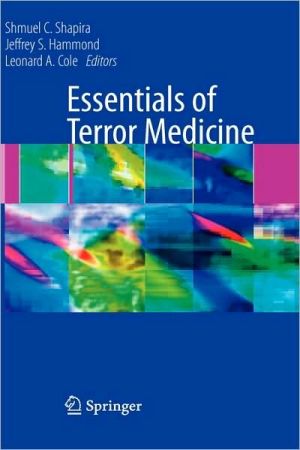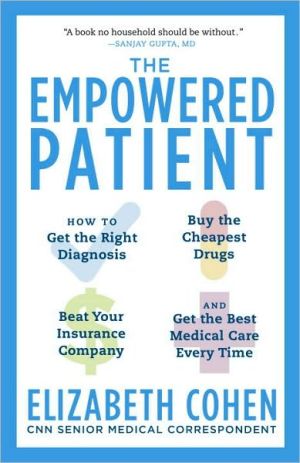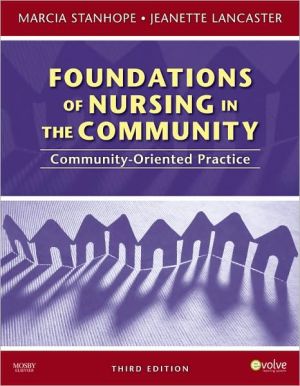Essentials of Terror Medicine
A new field of medicine has emerged as a result of the global proliferation of terrorism. Terror medicine is related to emergency and disaster medicine but focuses on the constellation of medical issues uniquely related to terrorist attacks. The field encompasses four broad areas: preparedness, incident management, mechanisms of injuries and responses, and psychological consequences. In Essentials of Terror Medicine, these core concerns are addressed by a distinguished international...
Search in google:
A new field of medicine has emerged as a result of the global proliferation of terrorism. Terror medicine is related to emergency and disaster medicine but focuses on the constellation of medical issues uniquely related to terrorist attacks. The field encompasses four broad areas: preparedness, incident management, mechanisms of injuries and responses, and psychological consequences. In Essentials of Terror Medicine, these core concerns are addressed by a distinguished international authorship brought together by the three editors of this volume, who themselves are recognized experts in relevant disciplines: Shmuel Shapira, epidemiology and hospital administration; Jeffrey Hammond, trauma surgery and emergency response; Leonard Cole, bioterrorism and public policy. Essentials of Terror Medicine provides insightful and practical information for physicians, nurses, emergency responders, and other health professionals who may be called to service during or after a terror incident. It is indispensable reading for the medical community of the 21st century, in which diligence, continued education, and careful preparation for a variety of possible events are a preeminent responsibility. Doody Review Services Reviewer:David J. Dries, MD(University of Minnesota Medical School)Description:An international group of authors present the basics of terror medicine.Purpose:As the majority of international healthcare practitioners are unaware of and unprepared for the medical consequences of terrorism, this is a valuable resource.Audience:Practitioners and trainees in emergency medicine, surgery, anesthesiology, and other specialties treating trauma are an appropriate audience for this work produced by international authorities. Administrators with responsibility for acute care programs may also benefit from this background material.Features:After an introduction to the demographics of terrorism in the 20th and 21st century, the book provides a chronological approach to disasters related to terrorism beginning with EMS response and continuing with characteristics of weapons used. Patterns of injury, ethics, psychological sequelae, and the forensics of terrorist incidents are then discussed. Chapters are clearly written and range in size from 10 to 20 pages. Tables, occasional black-and-white line drawings and black-and-white photographs are used and, while reproduction of all illustrations is good, photographs suffer from lack of contrast due to absence of color. Chapters are stocked with ample references featuring primary work from American and international journals. References date to within three years of the book's publication and clearly reflect the breadth of international work which has been done. Assessment:This is an excellent review from a field not featured in traditional training. The editors have effectively combined presentations from multiple countries and maintained a consistent presentation style. While some redundancy is inevitable in a work such as this, I recommend this resource for practitioners and hospitals serving in the acute care safety net.
Pt. I IntroductionCh. 1 Introduction to Terror Medicine Shmuel C. Shapira Shapira, Shmuel C. Jeffrey S. Hammond Hammond, Jeffrey S. Leonard A. Cole Cole, Leonard A. 3Ch. 2 Terrorism in the Twenty-First Century Boaz Ganor Ganor, Boaz 13Pt. II Preparation and ResponseCh. 3 EMS and Pre-Hospital Issues Ari Leppaniemi Leppaniemi, Ari 29Ch. 4 Effects of Terrorism on the Healthcare Community David O'Reilly O'Reilly, David Karim Brohi Brohi, Karim 45Ch. 5 Terror Medicine: Education and Training Yuri Millo Millo, Yuri 59Ch. 6 Modeling and Simulation in Terror Medicine Asher Hirshberg Hirshberg, Asher Kenneth L. Mattox Mattox, Kenneth L. 79Ch. 7 National Coordination and Integration Shlomo Mor-Yosef Mor-Yosef, Shlomo Shmuel C. Shapira Shapira, Shmuel C. 95Ch. 8 Response Planning Jorie D. Klein Klein, Jorie D. 111Ch. 9 Technology Opportunities and Challenges Annette L. Sobel Sobel, Annette L. 133Pt. III Weapon EtiologiesCh. 10 Epidemiology of Terrorism Injuries Limor Aharonson-Daniel Aharonson-Daniel, Limor Shmuel C. Shapira Shapira, Shmuel C. 149Ch. 11 Explosions and Blast Injury Eric R. Frykberg Frykberg, Eric R. 171Ch. 12 Biological Agents and Terror Medicine Meir Oren Oren, Meir 195Ch. 13 Chemical Agents and Terror Medicine Kristan Staudenmayer Staudenmayer, Kristan William P. Schecter Schecter, William P. 223Ch. 14 Radiological Agents and Tenor Medicine Jeffrey S. Hammond Hammond, Jeffrey S. Jill Lipoti Lipoti, Jill 241Ch. 15 Cyber- Terrorism: Preparation and Response Abraham R. Wagner Wagner, Abraham R. Zvi Fisch Fisch, Zvi 255Pt. IV Types of InjuryCh. 16 Penetrating Injury in Tenor Attacks Gidon Almogy Almogy, Gidon Avraham I.Rivkind Rivkind, Avraham I. 271Ch. 17 Orthopedic Injury in Urban Terrorism Meir Liebergall Liebergall, Meir Rami Mosheiff Mosheiff, Rami 287Ch. 18 Terror-Inflicted Burn Injury Tomer Tzur Tzur, Tomer Arieh Eldad Eldad, Arieh 299Ch. 19 Neurosurgical Injury Related to Terror Jeffrey V. Rosenfeld Rosenfeld, Jeffrey V. 313Ch. 20 Crush Injury, Crush Syndrome Moshe Michaelson Michaelson, Moshe 337Ch. 21 Maxillofacial Injury Related to Terror Eran Regev Regev, Eran Rephael Zeltser Zeltser, Rephael 347Ch. 22 Pediatrics and Terrorism David Markenson Markenson, David 365Pt. V Aftermath and Ethical ConsiderationsCh. 23 Forensic Investigation of Suicide Bombings Jehuda Hiss Hiss, Jehuda Tzipi Kahana Kahana, Tzipi 393Ch. 24 Psychological Effects of Terror Attacks Sara A. Freedman Freedman, Sara A. 405Ch. 25 Ethics and Terror Medicine Leonard A. Cole Cole, Leonard A. 425
\ From The CriticsReviewer: David J. Dries, MD(University of Minnesota Medical School)\ Description: An international group of authors present the basics of terror medicine.\ Purpose: As the majority of international healthcare practitioners are unaware of and unprepared for the medical consequences of terrorism, this is a valuable resource.\ Audience: Practitioners and trainees in emergency medicine, surgery, anesthesiology, and other specialties treating trauma are an appropriate audience for this work produced by international authorities. Administrators with responsibility for acute care programs may also benefit from this background material.\ Features: After an introduction to the demographics of terrorism in the 20th and 21st century, the book provides a chronological approach to disasters related to terrorism beginning with EMS response and continuing with characteristics of weapons used. Patterns of injury, ethics, psychological sequelae, and the forensics of terrorist incidents are then discussed. Chapters are clearly written and range in size from 10 to 20 pages. Tables, occasional black-and-white line drawings and black-and-white photographs are used and, while reproduction of all illustrations is good, photographs suffer from lack of contrast due to absence of color. Chapters are stocked with ample references featuring primary work from American and international journals. References date to within three years of the book's publication and clearly reflect the breadth of international work which has been done. \ Assessment: This is an excellent review from a field not featured in traditional training. The editors have effectively combined presentations from multiple countries and maintained a consistent presentation style. While some redundancy is inevitable in a work such as this, I recommend this resource for practitioners and hospitals serving in the acute care safety net.\ \








